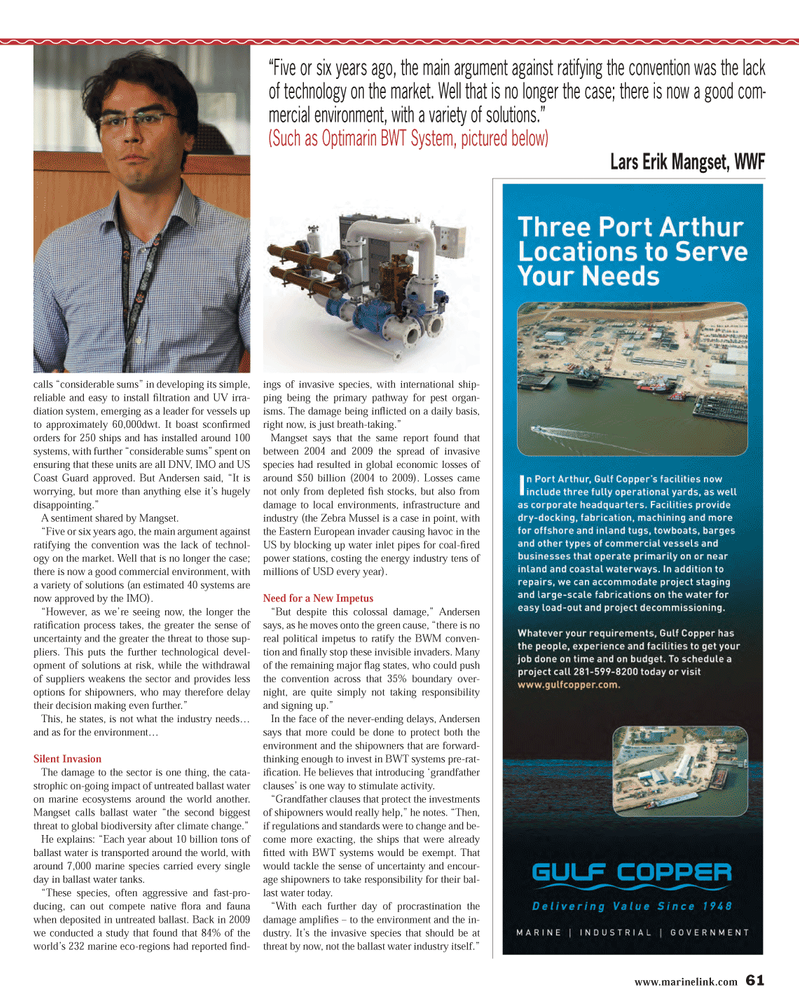
Page 61: of Maritime Reporter Magazine (November 2013)
Marine Propulsion Annual
Read this page in Pdf, Flash or Html5 edition of November 2013 Maritime Reporter Magazine
www.marinelink.com 61calls ?considerable sums? in developing its simple, reliable and easy to install Þ ltration and UV irra- diation system, emerging as a leader for vessels up to approximately 60,000dwt. It boast sconÞ rmed orders for 250 ships and has installed around 100 systems, with further ?considerable sums? spent on ensuring that these units are all DNV, IMO and US Coast Guard approved. But Andersen said, ?It is worrying, but more than anything else it?s hugely disappointing.?A sentiment shared by Mangset. ?Five or six years ago, the main argument against ratifying the convention was the lack of technol-ogy on the market. Well that is no longer the case; there is now a good commercial environment, with a variety of solutions (an estimated 40 systems are now approved by the IMO).?However, as we?re seeing now, the longer the ratiÞ cation process takes, the greater the sense of uncertainty and the greater the threat to those sup-pliers. This puts the further technological devel- opment of solutions at risk, while the withdrawal of suppliers weakens the sector and provides less options for shipowners, who may therefore delay their decision making even further.? This, he states, is not what the industry needs? and as for the environment?Silent InvasionThe damage to the sector is one thing, the cata-strophic on-going impact of untreated ballast water on marine ecosystems around the world another. Mangset calls ballast water ?the second biggest threat to global biodiversity after climate change.?He explains: ?Each year about 10 billion tons of ballast water is transported around the world, with around 7,000 marine species carried every single day in ballast water tanks. ?These species, often aggressive and fast-pro-ducing, can out compete native ß ora and fauna when deposited in untreated ballast. Back in 2009 we conducted a study that found that 84% of the world?s 232 marine eco-regions had reported Þ nd-ings of invasive species, with international ship-ping being the primary pathway for pest organ- isms. The damage being in ß icted on a daily basis, right now, is just breath-taking.? Mangset says that the same report found that between 2004 and 2009 the spread of invasive species had resulted in global economic losses of around $50 billion (2004 to 2009). Losses came not only from depleted Þ sh stocks, but also from damage to local environments, infrastructure and industry (the Zebra Mussel is a case in point, with the Eastern European invader causing havoc in the US by blocking up water inlet pipes for coal-Þ red power stations, costing the energy industry tens of millions of USD every year).Need for a New Impetus ?But despite this colossal damage,? Andersen says, as he moves onto the green cause, ?there is no real political impetus to ratify the BWM conven-tion and Þ nally stop these invisible invaders. Many of the remaining major ß ag states, who could push the convention across that 35% boundary over- night, are quite simply not taking responsibility and signing up.?In the face of the never-ending delays, Andersen says that more could be done to protect both the environment and the shipowners that are forward-thinking enough to invest in BWT systems pre-rat- iÞ cation. He believes that introducing ?grandfather clauses? is one way to stimulate activity. ?Grandfather clauses that protect the investments of shipowners would really help,? he notes. ?Then, if regulations and standards were to change and be-come more exacting, the ships that were already Þ tted with BWT systems would be exempt. That would tackle the sense of uncertainty and encour- age shipowners to take responsibility for their bal-last water today. ?With each further day of procrastination the damage ampliÞ es ? to the environment and the in- dustry. It?s the invasive species that should be at threat by now, not the ballast water industry itself.? ?Five or six years ago, the main argument against ratifying the convention was the lack of technology on the market. Well that is no longer the case; there is now a good com- mercial environment, with a variety of solutions.? (Such as Optimarin BWT System, pictured below)Lars Erik Mangset, WWFMR #11 (58-65).indd 61MR #11 (58-65).indd 6111/11/2013 12:15:47 PM11/11/2013 12:15:47 PM

 60
60

 62
62
